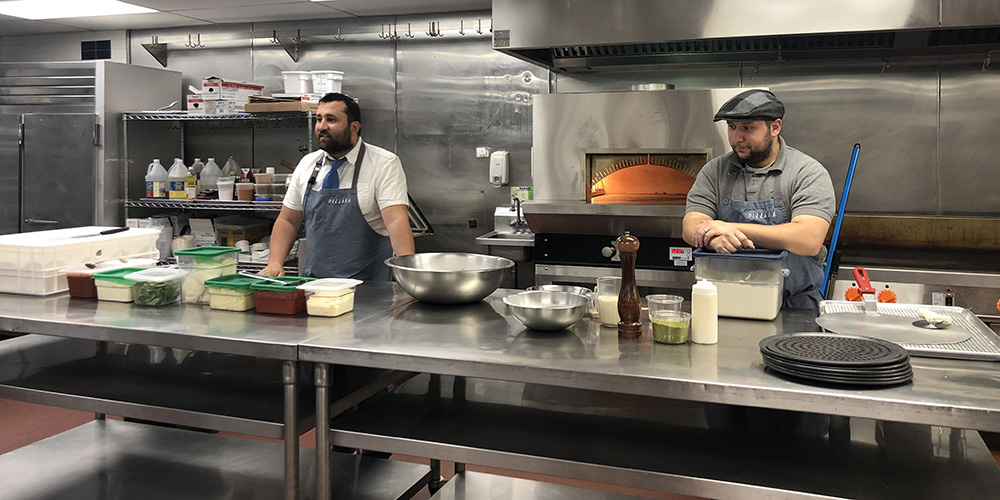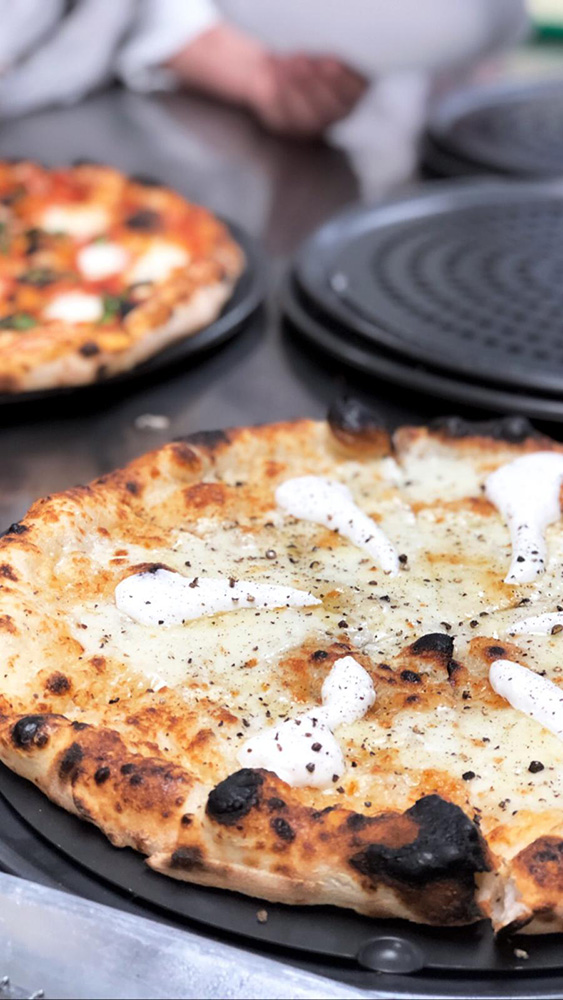
The Italian Chef and Pizzaiolo Behind Los Angeles’ Pizzana
Executive Chef Daniele Uditi shared the story of his pizzeria concept with students at ICE’s LA campus.
Originally from Naples, Italy, Chef Daniele Uditi was raised in a food-focused family. He began his career in the food industry at age 12, cleaning the pizza ovens and baking loaves of bread at his family’s bakery in Caserta, Italy, before school each morning.
Eventually, he went to work for Chef Rosanna Marziale at the Michelin-starred Le Colonne Marziale restaurant in his region of Campania, and in 2010, he traveled to Los Angeles to work as a consulting chef for various Italian restaurants. During that time, actor Chris O’Donnell — through hand gestures and a language barrier — asked if Chef Daniele would teach him how to make pizza. Now Chris and his wife, along with Sprinkles Founder Candace Nelson and her husband, are investors in Chef Daniele’s burgeoning Brentwood pizzeria, Pizzana, which is about to open a second West Hollywood location.
A reservation at two-year-old Pizzana is one of the toughest tables to nab, especially after the restaurant received critical praise from former LA Times reviewer and legendary food writer, Jonathan Gold. Chef Daniele showcased his pizza skills and discussed his career with students at the Institute of Culinary Education in Los Angeles. We asked him a few questions following the demonstration and lecture.

What inspired you to reimagine the Neapolitan cuisine of your youth with a concept in LA?
When I cook, I think about my family, my motherland and all those moments spent together sharing food around the table after baking bread in my auntie’s bakery. We’d use the leftover dough to make pizza that was crispy on the outside and soft on the inside and eat it together as a family. I decided to recreate that moment of communion with my family by using my experience as a Neapolitan pizzaiolo to make my own pizza that is based on those traditions and family recipes. The result is a pizza that is cut in slices and can be held in your hands without the ingredients falling off and can also be shared — two things that are difficult to do with a classic Neapolitan pizza due to the soft and watery texture.
One of those newly imagined pizzas is your cacio e pepe. How did that come to be on the menu at Pizzana?
My grandma was from Frosinone, near Rome, where the pasta dish comes from, and I remember her and my mother cooking it for me when I was a kid. I mean, it's cheese and pepper pasta, what kid doesn’t like that? My memory inspired me to recreate this dish as a pizza with just a few ingredients — fior di latte, young provolone and a Parmigiano Reggiano crema that gives you the creamy and salty pasta texture.

What are the keys to making Neapolitan pizza?
To make a proper Neapolitan pizza you only need a few ingredients, but each of those ingredients should be sourced and selected with care. For example, at Pizzana we use San Marzano tomatoes grown in the countryside of Naples and imported fior di latte cheese instead of mozzarella. True Neapolitan pizza is prepared in a wood-burning oven that reaches 750-800 degrees to cook the pizza in 60 seconds. But like I said, I don’t make Neapolitan pizza. Instead, I use my experience as a bread maker to cook the pizza a little longer to give it that crispy texture that reminds me of my childhood.
When it comes to the pizza oven, what are the important things to look for?
The pizza oven is the key to everything. You can make a great dough, but if you don’t have the right oven, it doesn’t mean anything. Look for good heat retention: the ability to reach the temperature you need without losing it easily. In the case of a wood oven, I tell people to look for good floor performance. It’s hard to find an oven where the stone is made right, but luckily that is changing, and better wood-burning ovens are becoming available.
What is the story behind your starter for your dough?
I use a starter called Criscito, which was started by my auntie 64 years ago. I transported the starter with me in a glass jar when I flew to the U.S. 10 years ago and risked being stopped by customs, but luckily succeeded without a problem.
How do you maintain it?
When people ask me what it is I tell them to think of it like a mother dough. You have to feed it flour everyday like your child needs food and water.
What do you want people to walk away with after experiencing your cuisine?
My goal from the beginning is to make people happy. Neo-Neapolitan cuisine is something that I was born thinking about — how we in Southern Italy treat the ingredients and make them shine and how we use all local produce to prove that you don’t need to import everything, but you can source around you and still make authentic Italian cuisine. After a meal, I want people to leave Pizzana with a happy memory — that’s my main goal.
What is your advice for chefs just starting out in the industry?
My biggest advice for a young chef is the same advice that my mom gave me when I decided to become a chef. She made me mark all the red dates on the calendar and told me, “When everybody is out having fun, you’ll be working in the kitchen. This is our job, are you sure you still want to do it?” And of course, I answered, "Yes!" But this job is not easy; if you work hard and you really love it, you will be rewarded, that’s for sure, but be ready because it takes a lot of dedication and sacrifice.
Pursue a career with your native cuisine and a Culinary Arts education.


Cooking
Submitted by Julio on April 3, 2019 1:07am
I love this article and all the ones before
thank you
Add new comment